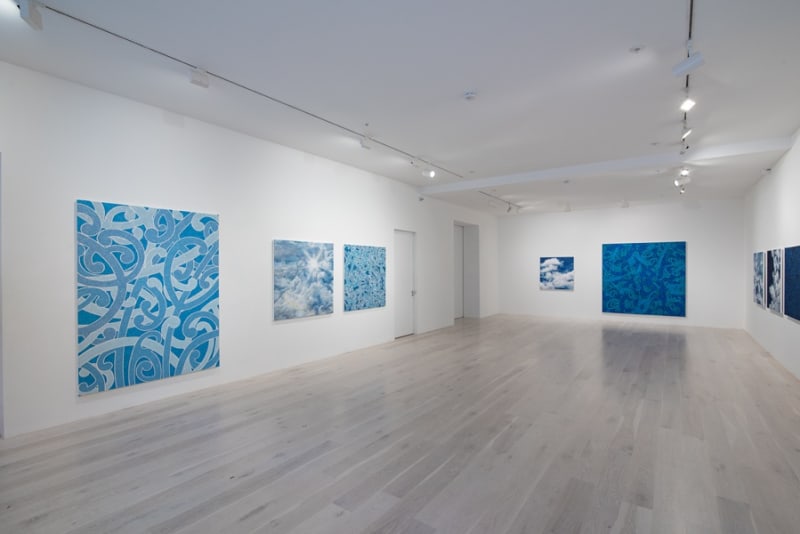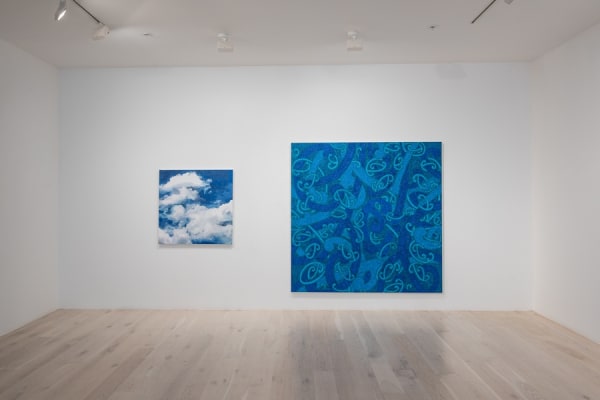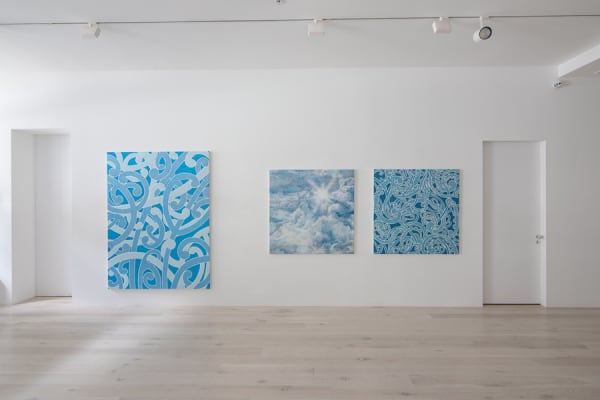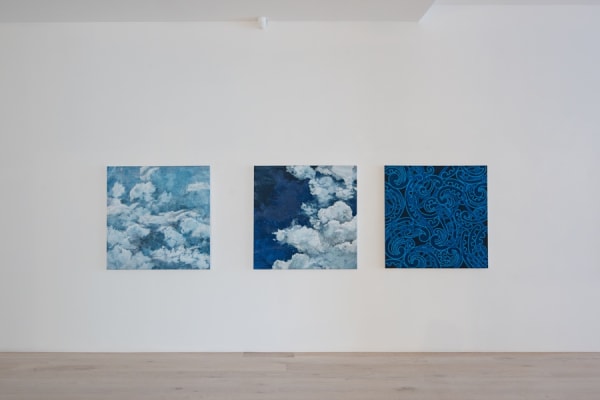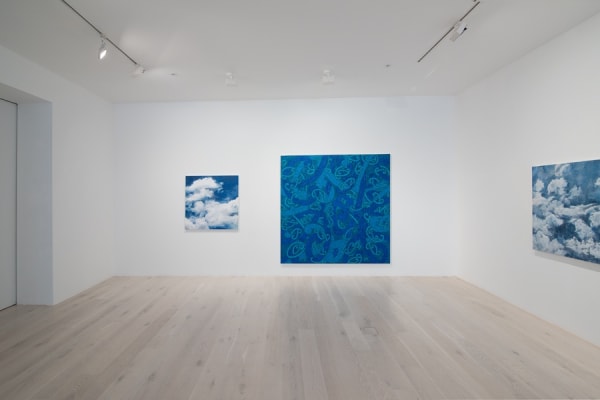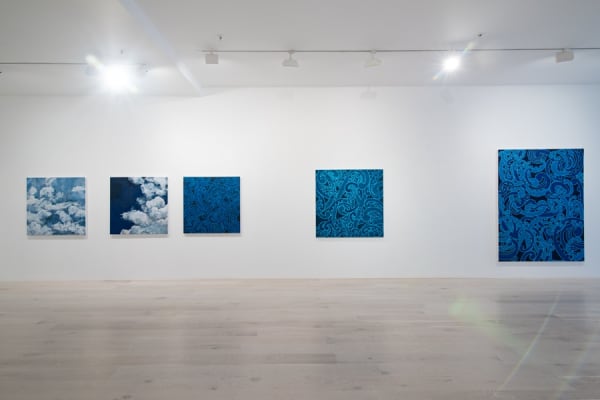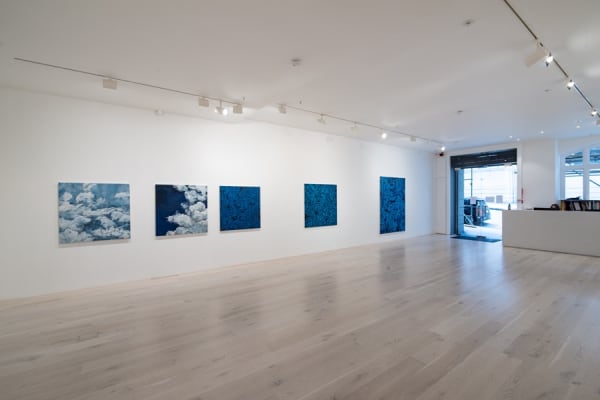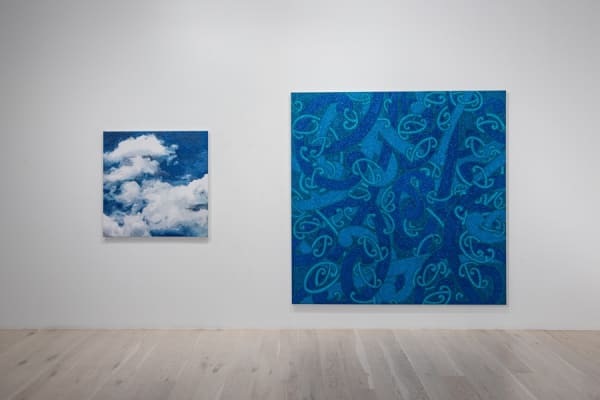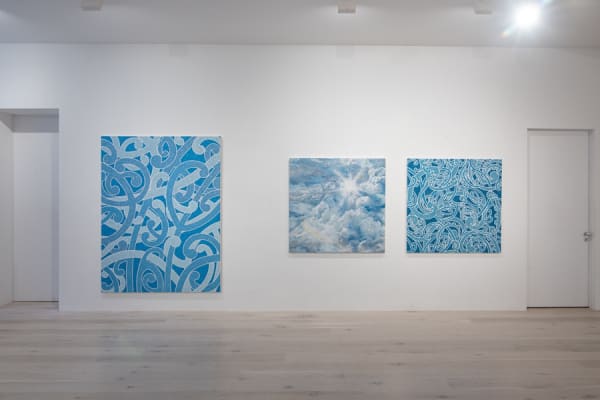Amen Break: Reuben Paterson
This new body of work takes me back to the early days of working with Reuben. After finishing art school, in 2000 he painted The Wharenui that Dad Built, a seminal work that acknowledged his father’s passing and marks the beginning of his exploration of his own whakapapa through art. And in glitter. Over the next three decades his subjects varied greatly; animals inspired by faux mink throws, retro patterns including one borrowed from a pair of his mum’s togs, botanical blooms, sublime skies, and fireworks. Which all play a part in the mapping of the artist’s journey.
Although Reuben’s practice has always referenced his Māori heritage, Amen Break sees him embrace his whakapapa head on with the use of kōwhaiwhai patterns. Here, partnered alongside cloud paintings, there is a new sense of discovery. Perhaps the return to traditional pattern is a reflection of a deepening of his own personal exploration of Te ao Māori. - Anna Jackson
Reuben Paterson’s largest work to date Guide Kaiārahi was installed on the forecourt of Auckland Art Gallery Toi o Tāmaki in July 2021. The 10-metre tall waka pītau carved in bright clear Perspex, fitted with nearly 600 crystals, comes to life at night when it refracts light and casts an eerie phantom-like shadow. Paterson intended this work as a “a guide, a leader and an escort”, opening questions around our journey on this earth, and journeys into the unknown and intangible. Paterson draws attention the interconnectedness of all entities of our world, a central concept of whakapapa in te ao Māori.
The works in this show are closely related to Guide Kaiārahi, and continue with the theme of journeying, but in a more contemplative way. The Kōwhaiwhai is traditionally found in wharenui meeting houses, each pattern is a mnemonic imbued with meaning. Traditionally these patterns, combined with other elements of the wharenui, create a framework to discuss philosophy and activate knowledge. The fluid curved forms in the kōwhaiwhai come from nature, and at their most basic, reconnect us with the natural world we come from and that nourishes us.
This new body of work takes me back to the early days of working with Reuben. After finishing art school, in 2000 he painted The Wharenui that Dad Built, a seminal work that acknowledged his father’s passing and marks the beginning of his exploration of his own whakapapa through art. And in glitter. Over the next three decades his subjects varied greatly; animals inspired by faux mink throws, retro patterns including one borrowed from a pair of his mum’s togs, botanical blooms, sublime skies, and fireworks. Which all play a part in the mapping of the artist’s journey.
Although Reuben’s practice has always referenced his Māori heritage, Amen Break sees him embrace his whakapapa head on with the use of kōwhaiwhai patterns. Here, partnered alongside cloud paintings, there is a new sense of discovery. Perhaps the return to traditional pattern is a reflection of a deepening of his own personal exploration of Te ao Māori. - Anna Jackson
Reuben Paterson’s largest work to date Guide Kaiārahi was installed on the forecourt of Auckland Art Gallery Toi o Tāmaki in July 2021. The 10-metre tall waka pītau carved in bright clear Perspex, fitted with nearly 600 crystals, comes to life at night when it refracts light and casts an eerie phantom-like shadow. Paterson intended this work as a “a guide, a leader and an escort”, opening questions around our journey on this earth, and journeys into the unknown and intangible. Paterson draws attention the interconnectedness of all entities of our world, a central concept of whakapapa in te ao Māori.
The works in this show are closely related to Guide Kaiārahi, and continue with the theme of journeying, but in a more contemplative way. The Kōwhaiwhai is traditionally found in wharenui meeting houses, each pattern is a mnemonic imbued with meaning. Traditionally these patterns, combined with other elements of the wharenui, create a framework to discuss philosophy and activate knowledge. The fluid curved forms in the kōwhaiwhai come from nature, and at their most basic, reconnect us with the natural world we come from and that nourishes us.
The title Amen Break refers to a music sample from soul musicians Winstons 1969 track Amen, Brother. In music terms a ‘break’ is where the song moves into a rhythmic interlude breaking the main part of the song, and often signals the start of a new section of the song. Look at the kōwhaiwhai patterns while listening to the Amen Break drum solo, these patterns will come to life, almost like a glitter covered still from a Len Lye film.
There is an otherworldly sensation in these images, the kōwhaiwhai proliferate on the canvas like microscopic organisms; juxtaposed by the realistic impressions of billowing clouds. These two viewpoints both stare at the sublime. A vision of the sky and the earth, Rangi-nui and Papatūānuku. In Māoridom, everything comes from the earth, yet in Western philosophy thought belongs in the sky. Paterson acts as a guide, taking us on an ethereal journey between worlds. He navigates us toward and through the sea and sky, the down and up, the under and over and the in-between.
*Please note, due to COVID-19 restrictions in Auckland, this exhibition is online only with restricted private viewing available under Level 3 protocols.
